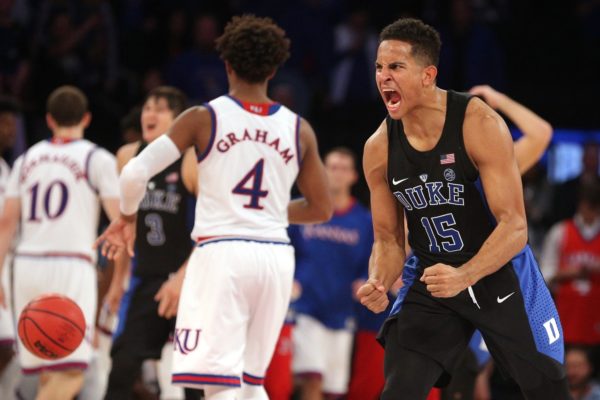Duke is Embracing Its Quasi-Point Guard Situation
Posted by Justin Kundrat on November 16th, 2016There’s a common misconception that every successful offense needs a primary ball-handler. Certainly at the collegiate level, some teams do. But Duke is not one of those teams, especially not this season. Point guards serve two critical roles in traditional offenses: 1) breaking pressure defense, and 2) initiating half-court offense. But in an era where wings and even forwards spend so much time developing “guard skills,” it’s no longer uncommon to see multiple initiators on the offensive end. Whether by choice or by circumstance, Duke has embraced this movement.

Frank Jackson is Duke’s Point Guard, But the Devils Really Operate the Position by Committee (USA Today Images)
Following the departure of the team’s last true playmaker, Tyus Jones, in 2015, the Blue Devils have since employed an amorphous offense that lacks a true lead guard. Derryck Thornton attempted to claim this role last season, but the offense ran more efficiently through others and eventually stayed that way. Duke’s motion-heavy offense this season revolves around numerous backcourt scoring threats that are equally capable of creating for teammates. “The Chris Pauls, there aren’t as many,” head coach Mike Krzyzewski recently said. “He’s the old-fashioned point guard, the leader. Now you have a lot of lead guards that score and could run a team, but they may not be the guy that runs the team.”
The result has been frustrating for Krzyzewski at times, particularly in transition settings where his team has been plagued by turnovers. But having multiple ball-handlers available who also pose as points of attack has obvious advantages. For one, natural shooters such as Luke Kennard, who is also a strong passer from the wing and high post, greatly fuels ball movement on the perimeter and can set up open looks on late closeouts. Putting freshman Frank Jackson into the lineup adds a rim-slashing dimension that also functions well in pick-and-roll settings. Jackson hasn’t yet fully adjusted comfortably to a distributor role, but his penetration threat creates ample opportunities. And most importantly, while not a true point guard, Grayson Allen is an absolute terror with the ball in his hands. As one of the most prolific scorers in the country, his presence draws defensive attention away from shooters such as Jackson, Kennard and Matt Jones.
Significant foul trouble against Kansas last night hampered Duke’s usual aggression in the low post, but smaller lineups with Amile Jefferson manning the paint and the 6’6″ Kennard playing a stretch forward role have otherwise proven successful. Even with six rotation players, Krzyzewski can toggle between his offensive and defensive looks by either playing Kennard at the four or putting Jefferson alongside Jeter. The two-point loss to Kansas is a tough pill to swallow, but the important takeaway from the Champions Classic for Duke remains that it can succeed without a true point guard on the roster. Given the abundance of on-ball scoring threats who can serve as legitimate ball-handlers, it’s no wonder that Duke succeeds in running its offense. Consider what will happen when three more legitimate scoring options arrive from the bench.










































